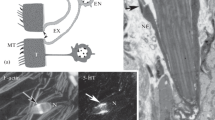Summary
Pycnophyes kielensis possesses one pair of protonephridia. The single excretory organ of a female consists of 25 cells: 22 terminal cells, 2 canal cells, and 1 nephroporus cell. Generally, all cells exhibit two cilia, the only exception being the nephroporus cell, which contains a diplosome instead. The slashed peripheral cytoplasmic walls of the 22 terminal cells altogether constitute one compound filter and a common filtration area. The protonephridia discharge via cuticularized cavities and six cuticularized tubes. Two accessory cells with modified cilia penetrate the nephroporus cell. These cells are considered to be receptor cells. The protonephridium of the first juvenile stage of P. kielensis is built up of only 5 cells: 3 terminal cells, 1 canal cell, and 1 nephroporus cell. It opens to the outside via 1 cuticularized tube. The protonephridia within both the Kinorhyncha and the Bilateria are discussed. Presumably excretory organs with compound filters developed independently within Bilateria.
Similar content being viewed by others
Abbreviations
- bb :
-
basal body
- c :
-
canal cell
- ca :
-
cuticularized cavity
- ci :
-
cilium
- cu :
-
cuticle
- d :
-
dictyosome
- de :
-
desmosome
- di :
-
diplosome
- dl :
-
dorsal longitudinal muscle
- dv :
-
dorsoventral muscle
- ecm :
-
extracellular matrix
- ep :
-
epidermal cell
- ex :
-
excretory organ
- fc :
-
filter cleft
- fi :
-
filter
- fm :
-
fastening muscle cell
- he :
-
hemidesmosome
- i :
-
intestine
- if :
-
intercellular fluid
- m :
-
mitochondrium
- mv :
-
microvilli
- n :
-
nephroporus cell
- nu :
-
nucleus
- r :
-
ciliary rootlet
- re :
-
accessory cell (presumable receptor cell)
- sj :
-
septate junction
- t :
-
terminal cell
- tu :
-
cuticularized tube
- v :
-
vesicle
- w :
-
peripheral cytoplasmic wall
References
Alberti G, Storch V (1986) Zur Ultrastruktur der Protonephridien von Tubiluchus philippinensis (Tubiluchidae, Priapulida). Zool Anz 217:259–271
Armonies W, Hellwig M (1986) Quantitative extraction of living meiofauna from marine and brackish muddy sediments. Mar Ecol Prog Ser 29:37–43
Ax P (1984) Das phylogenetische System. Systematisierung der lebenden Natur aufgrund ihrer Phylogenese. Fischer, Stuttgart New York
Ax P (1987) The phylogenetic system. Wiley, Chichester New York
Ehlers U (1985) Das phylogenetische System der Plathelminthes. Fischer, Stuttgart New York
Graebner I (1968) Erste Befunde über die Feinstruktur der Exkretionszellen der Gnathostomulidae (Gnathostomula paradoxa, Ax 1956 und Austrognathia riedli, Sterrer 1965). Mikroskopie 23:277–292
Horn TD (1978) The distribution of Echinoderes coulli (Kinorhyncha) along an interstitial salinity gradient. Trans Am Microsc Soc 97:586–589
Jespersen Å, Lützen J (1987) Ultrastructure of the nephridio-circulatory connections in Tubulanus annulatus (Nemertini, Anopla). Zoomorphology 107:181–189
Kümmel G (1964) Die Feinstruktur der Terminalzellen (Cyrtocyten) an den Protonephridien der Priapuliden. Z Zellforsch 62:468–484
Lammert V (1985) The fine structure of protonephridia in Gnathostomulida and their comparison within Bilateria. Zoomorphology 105:308–316
Merriman JA, Corwin HO (1973) An electron microscopical examination of Echinoderes dujardini Claparède (Kinorhyncha). Z Morphol Tiere 76:227–242
Neuhaus B (1987) Ultrastructure of the protonephridia in Dactylopodola baltica and Mesodasys laticaudatus (Macrodasyida): Implications for the ground pattern of the Gastrotricha. Microfauna Marina 3:419–438
Nørrevang A (1963) Fine structure of the solenocyte tree in Priapulus caudatus Lamarck. Nature 198:700–701
Nyholm K-G, Nyholm P-G (1976) Z-bodies and supercontraction in the integumental muscles of Homalorhaga Kinorhyncha. Zoon 4:131–136
Pitelka DR (1974) Basal bodies and root structures. In: Sleigh MA (ed) Cilia and flagella. Academic Press, London New York, pp 437–469
Smith PR, Ruppert EE, Gardiner SL (1987) A deuterostome-like nephridium in the mitraria larva of Owenia fusiformis (Polychaeta, Annelida). Biol Bull 172:315–323
Teuchert G (1973) Die Feinstruktur des Protonephridialsystems von Turbanella cornuta Remane, einem marinen Gastrotrich der Ordnung Macrodasyoidea. Z Zellforsch 136:277–289
Zelinka K (1928) Monographie der Echinodera. Engelmann, Leipzig
Author information
Authors and Affiliations
Rights and permissions
About this article
Cite this article
Neuhaus, B. Ultrastructure of the protonephridia in Pycnophyes kielensis (Kinorhyncha, Homalorhagida). Zoomorphology 108, 245–253 (1988). https://doi.org/10.1007/BF00312224
Received:
Issue Date:
DOI: https://doi.org/10.1007/BF00312224



